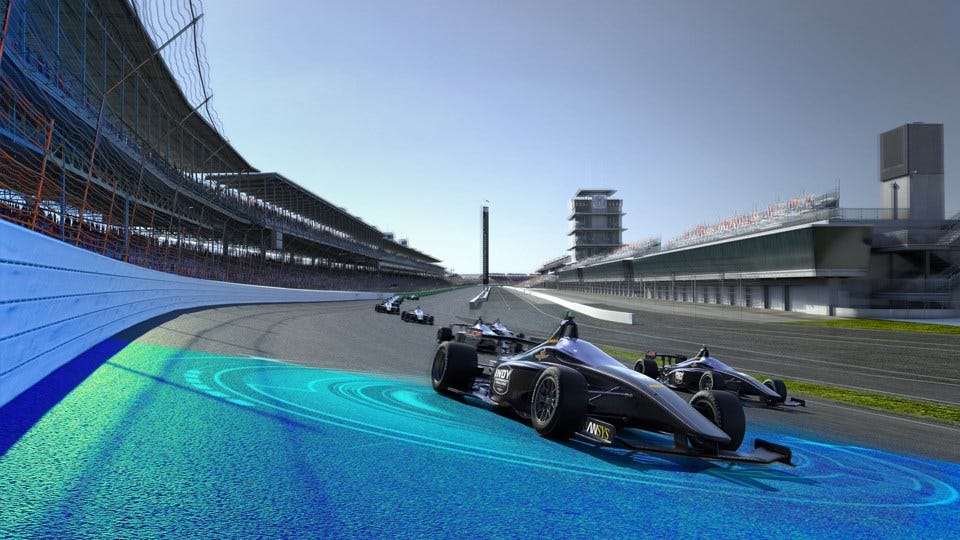Indy Autonomous Challenge Draws Global Talent
 Rendering of the test car for the Indy Autonomous Challenge at IMS
Rendering of the test car for the Indy Autonomous Challenge at IMS
Subscriber Benefit
As a subscriber you can listen to articles at work, in the car, or while you work out. Subscribe NowThe organizers of the Indy Autonomous Challenge are celebrating the global response to the inaugural $1.5 million prize competition. Energy Systems Network and the Indianapolis Motor Speedway say 31 teams from nearly 40 universities around the world have officially entered the challenge, which will culminate with modified race cars competing in a head-to-head, high-speed autonomous race around the famed oval in October 2021. ESN Managing Director Matt Peak says the response has been overwhelming since the competition was first announced in November.
In an interview with Inside INdiana Business, Peak said the global response shows how much interest there is in the subject of autonomous vehicle engineering.
“I think that creative, exciting, challenging projects around STEM…are in demand and nothing is sexier than automated race cars going at 200 miles per hour around the world’s most famous race track. So that has proven to be a magnet for all of these universities, for all of these students from around the world. So it’s enormous,” said Peak. “But then also, there’s other things that we’re really proving as well, which is that historical role of the Indianapolis Motor Speedway. For over 100 years, it has been a proving ground for new automotive technologies.”
The teams entered in the challenge represent 10 countries on four continents. All will be working toward the ultimate goal of advancing technology that would be used to speed up the commercialization of fully autonomous vehicles, as well as advanced driver-assistance systems.
“Testing technology for next generation vehicles is in our DNA, so the Indy Autonomous Challenge showcases our continued presence as a catalyst and proving ground for motorsport and transportation innovation,” IMS President Doug Boles said in a news release. “We are proud to provide the racing world’s biggest stage for the first head-to-head autonomous race in history, where these university teams will push the limits of performance and safety on the famed IMS oval—leading to safer and better cars on the highway.”
However, as with many efforts, the COVID-19 pandemic has had an impact on the challenge. Peak says the first aggregation of teams was scheduled to take place in May at the Indianapolis 500, which was postponed to August.
“We had a workshop planned and big festivities and whatnot,” said Peak. “So we had to move that to a purely online format and fortunately, we have very supportive sponsors that have stepped up and are a part of this competition. Ansys and Microsoft really led the charge for the online facilitation for these hundreds of students that turned out for this platform as we provided all the teams with software and other resources that are going to enable the competition. But also, we have very committed teams.”
He says organizers are keeping close tabs with the teams to make sure they have what they need as the various universities update their policies related to campus life and activities.
“There will be other opportunities to bring them together as our activities and as time progresses and so far, given the fact that the final competition isn’t planned to take place until 2021, we’re still full speed ahead. We envision this coming together next year where vehicles will be on the track, students will be in town and the final race takes place in October of ’21.”
The competition is a five-round challenge with each round becoming more difficult. Peak says the teams are being evaluated as they go along to ensure they are capable of taking part in an actual race at IMS. The challenge is currently in the third round, in which teams will compete in a simulated race. They will then move to on-the-ground vehicle testing next spring before the final round with the head-to-head race in October.
“It’s this continued aggressive process that we have to not just challenge these teams, but also to empower them as they go along and to ensure that every team that has the talent to go further is able to go further and just maximize their ability to show the world what they can do.”
Peak says while ESN and IMS are currently focused on the inaugural competition, there could be potential for future challenges.
The universities currently scheduled to compete include:
International Universities (15)
- Austria: Graz Univ. of Technology
- Canada: Univ. of Waterloo
- Germany (2): Karlsruhe Institute of Technology; Technical Univ. of Munich
- India (2): Indian Institute of Technology Madras; Amrita Vishwa Vidyapeetham
- Israel: Ariel Univ.
- Italy (3): Univ. of Pisa; Univ. of Modena; Politecnico di Milano
- Poland (2): Polish Academy of Sciences; Warsaw Univ. of Technology
- South Korea (2): Kookmin Univ.; Korea Advanced Institute of Science & Technology
- Switzerland: Eth Zurich
U.S. Universities (22)
- Alabama (2): Auburn Univ.; Univ. of Alabama
- California (2): UC Berkeley; California Polytechnic State Univ. (Cal Poly)
- Colorado: Colorado State Univ.
- Florida (2): Embry Riddle Aeronautical Univ.; Univ. of Florida
- Georgia: Kennesaw State Univ.
- Hawaii: Univ. of Hawaii
- Indiana (2): Indiana Univ.-Purdue Univ. (IUPUI).; Purdue Univ.
- Massachusetts: Massachusetts Institute of Technology (MIT)
- Michigan (3) Michigan State Univ.; Western Michigan Univ.; Univ. of Michigan-Dearborn
- New York (2): Rochester Institute of Technology (RIT); U.S. Military Academy (West Point)
- North Carolina: Univ. of North Carolina at Chapel Hill
- Pennsylvania: Univ. of Pittsburgh
- Texas: Texas A&M Univ.
- Virginia: Univ. of Virginia
- Wisconsin: Univ. of Wisconsin-Madison
Peak said the global response shows how much interest there is in the subject of autonomous vehicle engineering.
Peak says the COVID-19 pandemic has had an early impact on the challenge.
